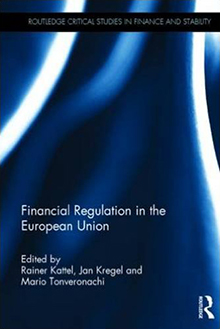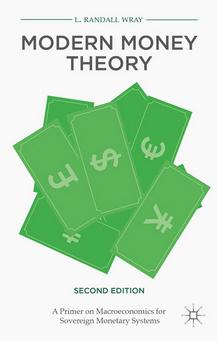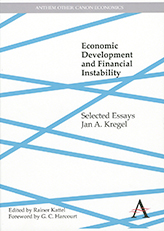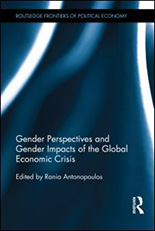
Research Topics
Publications on Finance
-
Moral Hazard and the State Budget Crisis
One-Pager No. 64 | August 2020As congressional negotiations stall and state governments are poised to enact significant austerity, Alex Williams argues that fiscal aid to state governments should be tied to economic indicators rather than the capriciousness of federal legislators. Building this case for reform requires confronting a common objection: that state fiscal aid creates situations of moral hazard. This objection misconstrues the agency of state governments and misunderstands the incentives of federal politicians, according to Williams. There is a serious moral hazard problem involved here—but it is not the one widely claimed.Download:Associated Programs:Author(s):Alex Williams -
Moral Hazard in a Modern Federation
Public Policy Brief No. 152, 2020 | August 2020The mainstream fiscal federalism literature has led to an instinctive belief that states receiving fiscal aid during a recession are taking advantage of the federal government in pursuit of localized benefits with dispersed costs. This policy brief by Alex Williams challenges this unreflective argument and, in response, offers a novel framework for understanding the relationship between the business cycle and fiscal federalism in the United States.
Utilizing the work of Michael Pettis, Williams demonstrates that a government unable to design its own capital structure is not meaningfully an agent with respect to the business cycle. As such, they cannot be considered agents in a moral hazard problem when receiving support from the federal government during a recession.
From the perspective of this policy brief, the operative moral hazard problem is one in which federal-level politicians reap a political benefit from a seemingly principled refusal to increase federal spending, while avoiding blame for crisis and austerity at the state and local government level. Williams’ proposed solution is to impose macroeconomic discipline on federal policymakers by creating automatic stabilizers that take decisions about the level of state fiscal aid in a recession out of their hands.Download:Associated Programs:Author(s):Alex Williams -
Democratizing Money
Working Paper No. 928 | May 2019In the Western interpretation of democracy, governments exist in order to manage relations of property, with absence of property ownership leading to exclusion from participation in governance and, in many cases, absence of equal treatment before the law. Democratizing money will therefore ensure equal opportunity to the ownership of property, and thus full participation in the democratic governance of society, as well as equal access to the banking system, which finances the creation of capital via the creation of money. If the divergence between capital and labor—between rich and poor—is explained by the monopoly access of capitalists to finance, then reducing this divergence is crucially dependent on the democratization of money. Though the role of money and finance in determining inequality between capital and labor transcends any particular understanding of the process by which the creation of money leads to inequity, specific proposals for the democratization of money will depend on the explanation of how money comes into existence and how it supports capital accumulation.Download:Associated Programs:Author(s):Jan Kregel -
Financial Regulation in the European Union
Book Series, November 2015 | November 2015Edited by Rainer Kattel, Jan Kregel, and Mario Tonveronachi

Have past and more recent regulatory changes contributed to increased financial stability in the European Union (EU), or have they improved the efficiency of individual banks and national financial systems within the EU? Edited by Rainer Kattel, Tallinn University of Technology, Director of Research Jan Kregel, and Mario Tonveronachi, University of Siena, this volume offers a comparative overview of how financial regulations have evolved in various European countries since the introduction of the single European market in 1986. The collection includes a number of country studies (France, Germany, Italy, Spain, Estonia, Hungary, Slovenia) that analyze the domestic financial regulatory structure at the beginning of the period, how the EU directives have been introduced into domestic legislation, and their impact on the financial structure of the economy. Other contributions examine regulatory changes in the UK and Nordic countries, and in postcrisis America.
Published by: Routledge
Associated Program: -
Modern Money Theory: A Primer on Macroeconomics for Sovereign Monetary Systems, Second Edition
Book Series, September 2015 | September 2015By L. Randall Wray

In a completely revised second edition, Senior Scholar L. Randall Wray presents the key principles of Modern Money Theory, exploring macro accounting, monetary and fiscal policy, currency regimes, and exchange rates in developed and developing nations. Wray examines how misunderstandings about the nature of money caused the recent global financial meltdown, and provides fresh ideas about how leaders should approach economic policy. This updated edition also includes new chapters on tax policies and inflation.
Published by: Palgrave Macmillan
-
Financing the Capital Development of the Economy
Working Paper No. 837 | May 2015A Keynes-Schumpeter-Minsky Synthesis
This paper discusses the role that finance plays in promoting the capital development of the economy, with particular emphasis on the current situation of the United States and the United Kingdom. We define both “finance” and “capital development” very broadly. We begin with the observation that the financial system evolved over the postwar period, from one in which closely regulated and chartered commercial banks were dominant to one in which financial markets dominate the system. Over this period, the financial system grew rapidly relative to the nonfinancial sector, rising from about 10 percent of value added and a 10 percent share of corporate profits to 20 percent of value added and 40 percent of corporate profits in the United States. To a large degree, this was because finance, instead of financing the capital development of the economy, was financing itself. At the same time, the capital development of the economy suffered perceptibly. If we apply a broad definition—to include technological advances, rising labor productivity, public and private infrastructure, innovations, and the advance of human knowledge—the rate of growth of capacity has slowed.
The past quarter century witnessed the greatest explosion of financial innovation the world had ever seen. Financial fragility grew until the economy collapsed into the global financial crisis. At the same time, we saw that much (or even most) of the financial innovation was directed outside the sphere of production—to complex financial instruments related to securitized mortgages, to commodities futures, and to a range of other financial derivatives. Unlike J. A. Schumpeter, Hyman Minsky did not see the banker merely as the ephor of capitalism, but as its key source of instability. Furthermore, due to “financialisation of the real economy,” the picture is not simply one of runaway finance and an investment-starved real economy, but one where the real economy itself has retreated from funding investment opportunities and is instead either hoarding cash or using corporate profits for speculative investments such as share buybacks. As we will argue, financialization is rooted in predation; in Matt Taibbi’s famous phrase, Wall Street behaves like a giant, blood-sucking “vampire squid.”
In this paper we will investigate financial reforms as well as other government policy that is necessary to promote the capital development of the economy, paying particular attention to increasing funding of the innovation process. For that reason, we will look not only to Minsky’s ideas on the financial system, but also to Schumpeter’s views on financing innovation.
-
Building the Entrepreneurial State
Working Paper No. 824 | January 2015A New Framework for Envisioning and Evaluating a Mission-oriented Public Sector
Today, countries around the world are seeking “smart” innovation-led growth, and hoping that this growth is also more “inclusive” and “sustainable” than in the past. This paper argues that such a feat requires rethinking the role of government and public policy in the economy—not only funding the “rate” of innovation, but also envisioning its “direction.” It requires a new justification of government intervention that goes beyond the usual one of “fixing market failures.” It also requires the shaping and creating of markets. And to render such growth more “inclusive,” it requires attention to the ensuing distribution of “risks and rewards.”
To approach the innovation challenge of the future, we must redirect the discussion, away from the worry about “picking winners” and “crowding out” toward four key questions for the future:- Directions: how can public policy be understood in terms of setting the direction and route of change; that is, shaping and creating markets rather than just fixing them? What can be learned from the ways in which directions were set in the past, and how can we stimulate more democratic debate about such directionality?
- Evaluation: how can an alternative conceptualization of the role of the public sector in the economy (alternative to MFT) translate into new indicators and assessment tools for evaluating public policies beyond the microeconomic cost/benefit analysis? How does this alter the crowding in/out narrative?
- Organizational change: how should public organizations be structured so they accommodate the risk-taking and explorative capacity, and the capabilities needed to envision and manage contemporary challenges?
- Risks and Rewards: how can this alternative conceptualization be implemented so that it frames investment tools so that they not only socialize risk, but also have the potential to socialize the rewards that enable “smart growth” to also be “inclusive growth”?
Download:Associated Programs:Author(s):Mariana Mazzucato -
Economic Development and Financial Instability: Selected Essays
Book Series, October 2014 | October 2014By Jan A. Kregel. Edited by Rainer Kattel. Foreword by G. C. Harcourt.
 This volume is the first collection of essays by Jan Kregel focusing on the role of finance in development and growth, and it demonstrates the extraordinary depth and breadth of this economist’s work. Considered the “best all-round general economist alive” (Harcourt), Kregel is a senior scholar and director of the monetary policy and financial structure program at the Levy Economics Institute, and professor of development finance at Tallinn University of Technology. These essays reflect his deep understanding of the nature of money and finance and of the institutions associated with them, and of the indissoluble relationship between these institutions and the real economy—whether in developed or developing economies. Kregel has expanded Hyman Minsky’s original premise that in capitalist economies stability engenders instability, and Kregel’s key works on financial instability, its causes and effects, as well as his discussions of the global financial crisis and Great Recession, are included here.
Published by: Anthem Press
This volume is the first collection of essays by Jan Kregel focusing on the role of finance in development and growth, and it demonstrates the extraordinary depth and breadth of this economist’s work. Considered the “best all-round general economist alive” (Harcourt), Kregel is a senior scholar and director of the monetary policy and financial structure program at the Levy Economics Institute, and professor of development finance at Tallinn University of Technology. These essays reflect his deep understanding of the nature of money and finance and of the institutions associated with them, and of the indissoluble relationship between these institutions and the real economy—whether in developed or developing economies. Kregel has expanded Hyman Minsky’s original premise that in capitalist economies stability engenders instability, and Kregel’s key works on financial instability, its causes and effects, as well as his discussions of the global financial crisis and Great Recession, are included here.
Published by: Anthem Press
-
What Do We Know About the Labor Share and the Profit Share? Part II
Working Paper No. 804 | May 2014Empirical Studies
In this second part of our study we survey the rapidly expanding empirical literature on the determinants of the functional distribution of income. Three major strands emerge: technological change, international trade, and financialization. All contribute to the fluctuations of the labor share, and there is a significant amount of self-reinforcement among these factors. For the case of the United States, it seems that the factors listed above are by order of increasing importance. We conclude by noting that the falling US wage shares cointegrates with rising inequality and a rising top 1 percent income share. Thus, all measures of income distribution provide the same picture. Liberalization and financialization worsen economic inequality by raising top incomes, unless institutions are strongly redistributive.
The labor share has also fallen, for structural reasons and for reasons related to economic policy. Such explanations are left to parts III and IV of our study, respectively. Part I investigated the theories of income distribution.
Download:Associated Program:Author(s): -
Gender Perspectives and Gender Impacts of the Global Economic Crisis
Book Series, December 2013 | December 2013Edited by Rania Antonopoulos

With the full effects of the Great Recession still unfolding, this collection of essays analyzes the gendered economic impacts of the crisis. The volume, from an international set of contributors, argues that gender-differentiated economic roles and responsibilities within households and markets can potentially influence the ways in which men and women are affected in times of economic crisis.
Looking at the economy through a gender lens, the contributors investigate the antecedents and consequences of the ongoing crisis as well as the recovery policies adopted in selected countries. There are case studies devoted to Latin America, transition economies, China, India, South Africa, Turkey, and the United States. Topics examined include unemployment, the job-creation potential of fiscal expansion, the behavioral response of individuals whose households have experienced loss of income, social protection initiatives, food security and the environment, shedding of jobs in export-led sectors, and lessons learned thus far. From these timely contributions, students, scholars, and policymakers are certain to better understand the theoretical and empirical linkages between gender equality and macroeconomic policy in times of crisis.
Published by: Routledge
-
Causes of Financial Instability
Working Paper No. 665 | April 2011Don’t Forget Finance
Given the economy’s complex behavior and sudden transitions as evidenced in the 2007–08 crisis, agent-based models are widely considered a promising alternative to current macroeconomic practice dominated by DSGE models. Their failure is commonly interpreted as a failure to incorporate heterogeneous interacting agents. This paper explains that complex behavior and sudden transitions also arise from the economy’s financial structure as reflected in its balance sheets, not just from heterogeneous interacting agents. It introduces “flow-of-funds” and “accounting” models, which were preeminent in successful anticipations of the recent crisis. In illustration, a simple balance-sheet model of the economy is developed to demonstrate that nonlinear behavior and sudden transition may arise from the economy’s balance-sheet structure, even without any microfoundations. The paper concludes by discussing one recent example of combining flow-of-funds and agent-based models. This appears a promising avenue for future research.
Download:Associated Programs:Author(s):Dirk Bezemer -
The Financial Crisis Viewed from the Perspective of the “Social Costs” Theory
Working Paper No. 662 | March 2011This paper examines the causes and consequences of the current global financial crisis. It largely relies on the work of Hyman Minsky, although analyses by John Kenneth Galbraith and Thorstein Veblen of the causes of the 1930s collapse are used to show similarities between the two crises. K.W. Kapp’s “social costs” theory is contrasted with the recently dominant “efficient markets” hypothesis to provide the context for analyzing the functioning of financial institutions. The paper argues that, rather than operating “efficiently,” the financial sector has been imposing huge costs on the economy—costs that no one can deny in the aftermath of the economy’s collapse. While orthodox approaches lead to the conclusion that money and finance should not matter much, the alternative tradition—from Veblen and Keynes to Galbraith and Minsky—provides the basis for developing an approach that puts money and finance front and center. Including the theory of social costs also generates policy recommendations more appropriate to an economy in which finance matters.
Download:Associated Program:Author(s): -
Money in Finance
Working Paper No. 656 | March 2011This paper begins by defining, and distinguishing between, money and finance, and addresses alternative ways of financing spending. We next examine the role played by financial institutions (e.g., banks) in the provision of finance. The role of government as both regulator of private institutions and provider of finance is also discussed, and related topics such as liquidity and saving are explored. We conclude with a look at some of the new innovations in finance, and at the global financial crisis, which could be blamed on excessive financialization of the economy.
Download:Associated Program:Author(s): -
An Alternative View of Finance, Saving, Deficits, and Liquidity
Working Paper No. 580 | October 2009This paper contrasts the orthodox approach with an alternative view on finance, saving, deficits, and liquidity. The conventional view on the cause of the current global financial crisis points first to excessive United States trade deficits that are supposed to have “soaked up” global savings. Worse, this policy was ultimately unsustainable because it was inevitable that lenders would stop the flow of dollars. Problems were compounded by the Federal Reserve’s pursuit of a low-interest-rate policy, which involved pumping liquidity into the markets and thereby fueling a real estate boom. Finally, with the world awash in dollars, a run on the dollar caused it to collapse. The Fed (and then the Treasury) had to come to the rescue of US banks, firms, and households. When asset prices plummeted, the financial crisis spread to much of the rest of the world. According to the conventional view, China, as the residual supplier of dollars, now holds the fate of the United States, and possibly the entire world, in its hands. Thus, it’s necessary for the United States to begin living within its means, by balancing its current account and (eventually) eliminating its budget deficit.
I challenge every aspect of this interpretation. Our nation operates with a sovereign currency, one that is issued by a sovereign government that operates with a flexible exchange rate. As such, the government does not really borrow, nor can foreigners be the source of dollars. Rather, it is the US current account deficit that supplies the net dollar saving to the rest of the world, and the federal government budget deficit that supplies the net dollar saving to the nongovernment sector. Further, saving is never a source of finance; rather, private lending creates bank deposits to finance spending that generates income. Some of this income can be saved, so the second part of the saving decision concerns the form in which savings might be held—as liquid or illiquid assets. US current account deficits and federal budget deficits are sustainable, so the United States does not need to adopt austerity, nor does it need to look to the rest of the world for salvation. Rather, it needs to look to domestic fiscal stimulus strategies to resolve the crisis, and to a larger future role for government in helping to stabilize the economy.
Download:Associated Program:Author(s):
